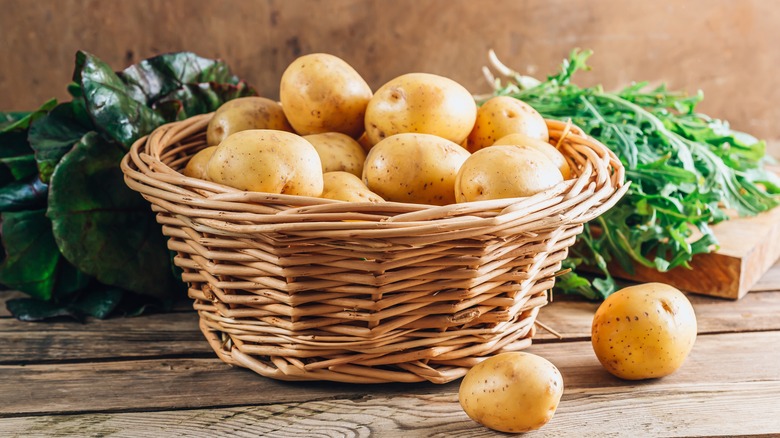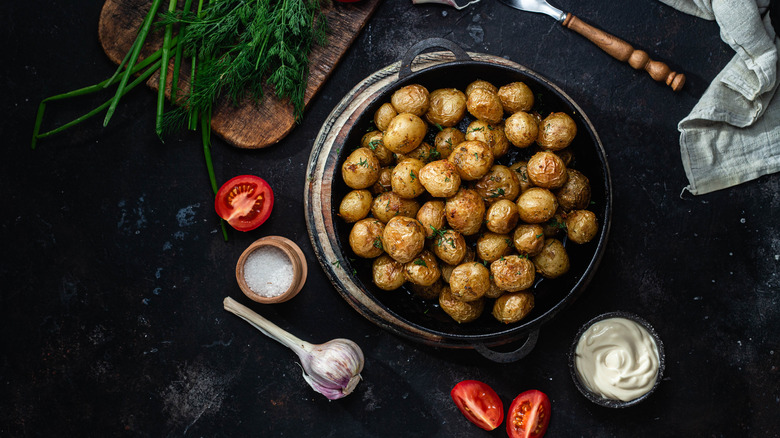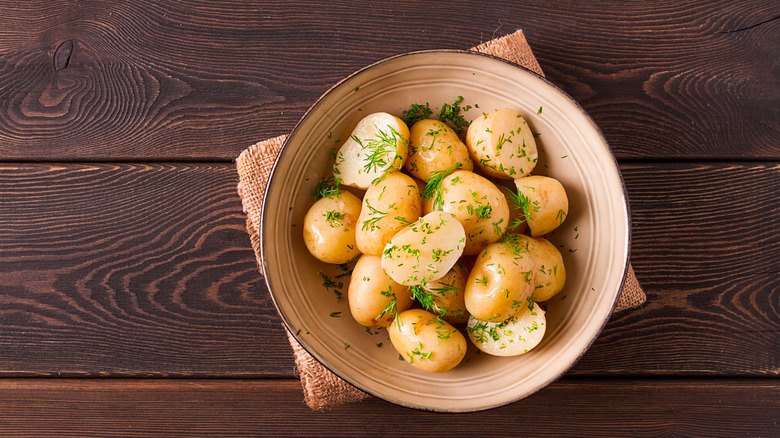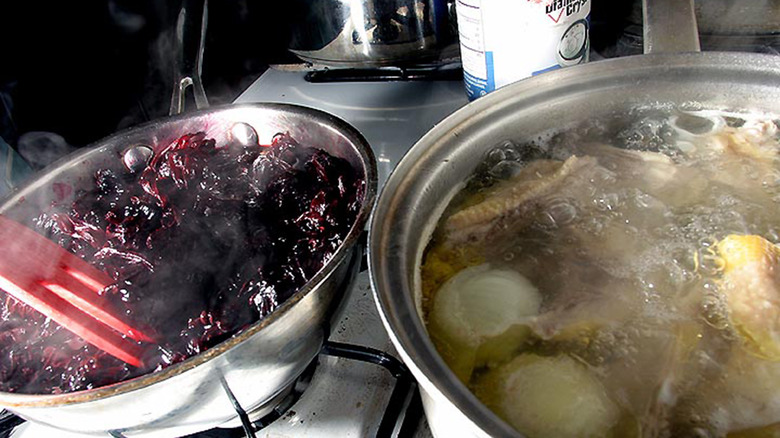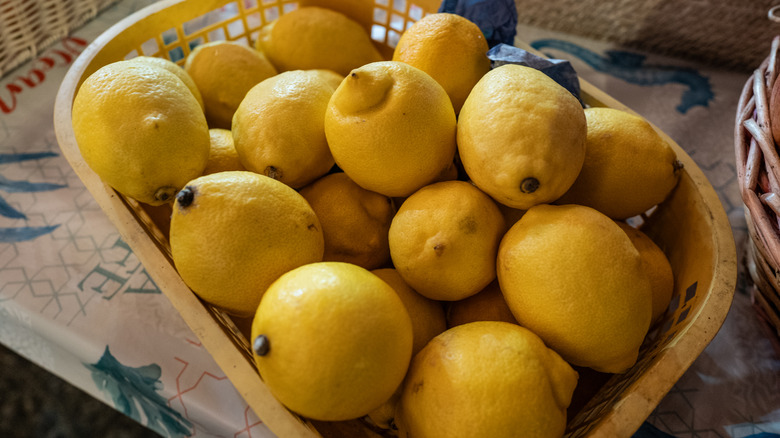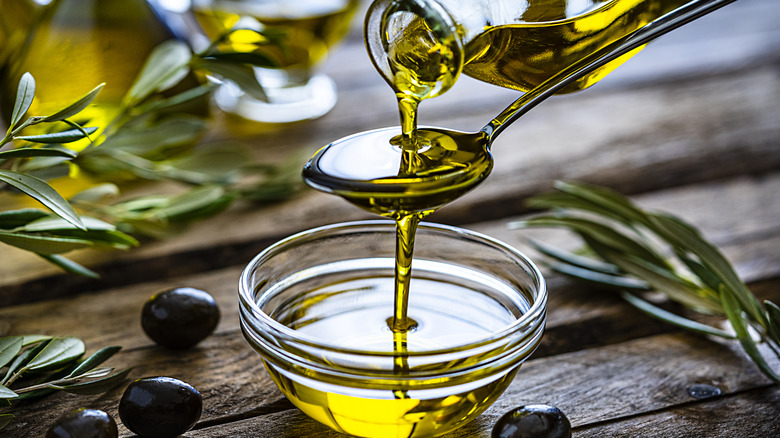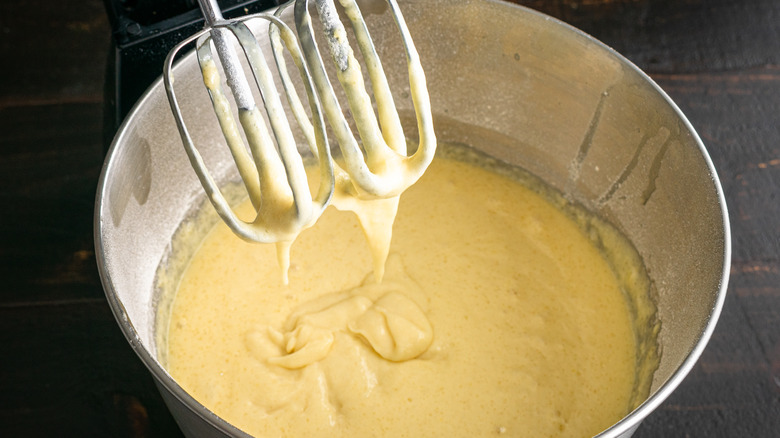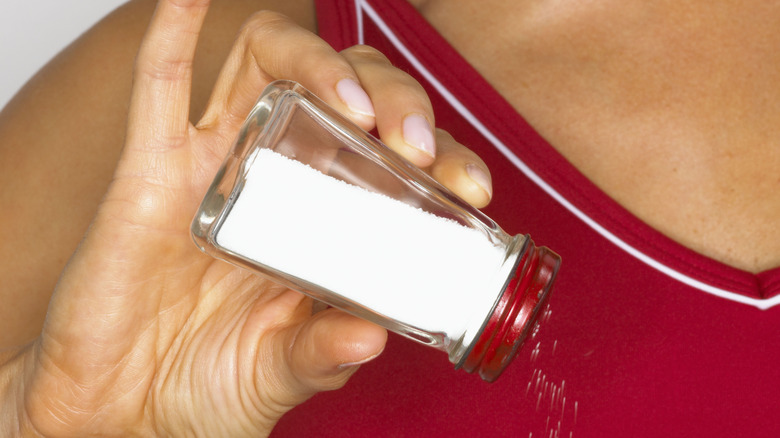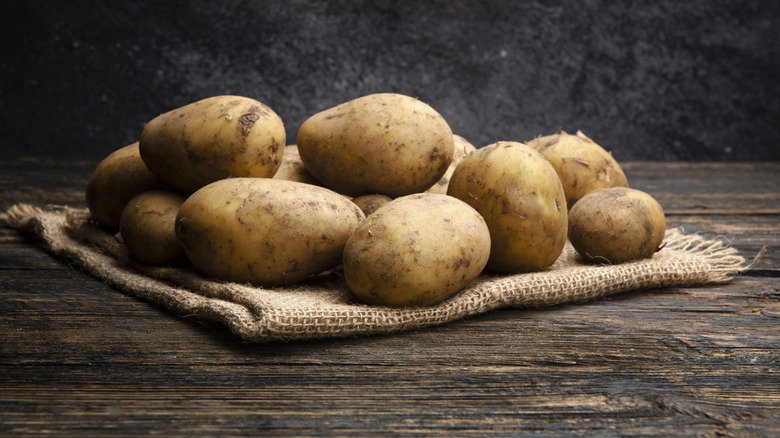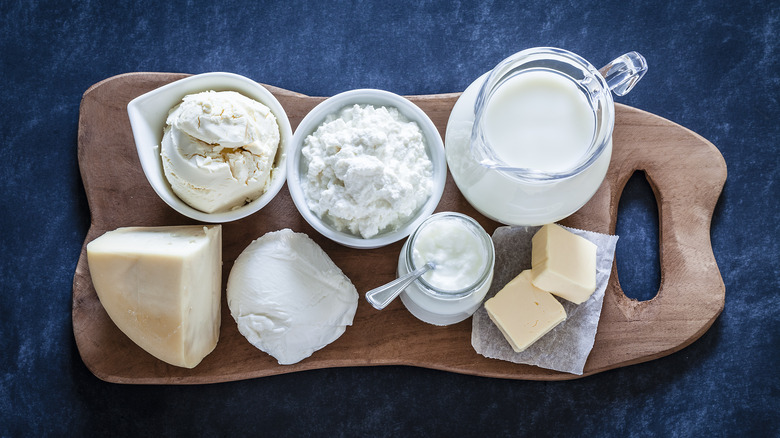13 Hacks That Will Change The Way You Cook With Frozen Baby Potatoes
Frozen baby potatoes are a staple in many households thanks to their convenience and almost infinite shelf life. However, anyone who's cooked them straight from the freezer knows that they can often turn out quite bland and mushy if not handled with a little extra care and creativity. It's quite common to fall into the trap of just tossing them into the oven or microwave, only to be met with a less-than-satisfying result.
But fear not, because we're about to take your frozen baby potato game to the next level. With a few clever hacks and twists, you can elevate these humble frozen spuds into a gourmet side dish that could steal the show in any meal. These tips are not only easy to incorporate into your kitchen routine but will also infuse a burst of flavor and the perfect texture to your baby potatoes. Whether you like to freeze your own potatoes or just pick pre-frozen ones up at the store, you'll know how to make them into something delicious.
1. Choose firm potatoes without blemishes
When your end goal is to create a dish that impresses, it's crucial to begin with top-notch ingredients. For frozen baby potatoes, this means being selective about what potatoes you include. If you're doing a DIY freeze, pick potatoes that are firm to the touch and free of blemishes, cuts, or dark spots.
These attributes aren't just about aesthetics. They directly influence how your potatoes will cook and taste. A firm potato is less likely to become mushy and will maintain its shape and texture through the cooking process. Additionally, the absence of blemishes indicates a healthy, quality potato, which translates to better flavor.
Making this careful selection during your groceries will pay dividends in the end, allowing all the other tricks and hacks you've employed to truly shine. By starting with the best possible potatoes, you're setting yourself up for culinary success, ensuring that everything from texture to flavor hits the mark.
2. Choose low water count potatoes
A crucial factor in selecting potatoes for any kind of dish is their inherent water content. It's not just about firmness and visual appeal — you should also be aware of the water content in the variety you choose to freeze and cook later. Selecting low-moisture baby potatoes is beneficial because these varieties are less prone to building up ice crystals during freezing. Ice crystals are the enemy of good texture, leading to a final product that can be watery or mushy.
It might require some research or label-reading, but it's time well spent. A group of potatoes called "starchy potatoes" are best as they are high-starch potatoes with a low water count. These include Russet potatoes, Idaho potatoes, and red potatoes.
By focusing on the moisture content, you're preemptively tackling one of the biggest challenges of cooking with frozen baby potatoes. It's an impactful step that prepares you for a better, tastier outcome.
3. Prep your potatoes before you freeze them
Before tucking them into their icy bed in the freezer, invest a little time in getting your spuds all set and ready. Starting this process earlier will drastically reduce the hassle and time expenditure when you eventually get to the crucial cooking phase.
First off, give your baby potatoes a good rinse to remove any dirt or impurities. This initial step ensures you'll have clean, appetizing potatoes. Then, start crafting them into the delightful shapes and forms that will eventually grace your dining table. The world is your oyster here — choose a style that resonates well with your family's taste buds. You can leave them whole, smash them, and don't overlook the classic choice of dicing them for a batch of scrumptious oven-roasted potatoes, a versatile option that pairs well with many main courses. Decide whether you'll need the skins — the air fryer makes them nice and crispy — or if you'll need to peel them off before you freeze.
The goal here is to create a convenient, yet delightful culinary experience where enjoyment meets simplicity.
4. Blanch your potatoes before freezing
To ensure the perfect texture, it's essential to partially cook your potatoes before giving them a chilly resting place in your freezer. Successfully storing spuds requires blanching them before freezing. Uncooked potatoes don't fare well in freezing temperatures, given their high water content, giving them a soft or even gritty texture.
While it might seem like a pain to pre-cook your baby potatoes, look at it as a strategy to save precious time later on. Pre-cooked potatoes will reduce your bake or boil time later on, especially during holidays or parties where many dishes might be vying for oven time. By adopting this approach, not only do you conserve valuable time, but you also enhance the texture and flavor, promising a delightful dining experience that showcases your culinary prowess, especially during family gatherings where you don't want to be known as the person who made the soggy, mushy potatoes.
5. Add acidity to your potatoes to refresh the flavor
Elevate the savoriness of your spuds by incorporating a hint of tang to them. Pair frozen potatoes with slightly sour elements to boost their inherent tuberous essence. It's a known culinary trick that the zest of acidic components can accentuate and revive the flavors of bland potatoes, making them pop in a delightful way.
Garnishing your potatoes with tart condiments that are commonly available in your pantry. Incorporating a splash of citrus juice or a dash of vinegar can introduce a surprising yet pleasant contrast to the rich, hearty flavor of potatoes. Spicing things up with a dribble of hot sauce or ketchup can elevate the taste as well.
Avoid going too heavy with liquid-based acidic additions, as they have the potential to make your potatoes go from crispy to mushy quickly. To retain the firm texture, add a fine mist of these elements as your potatoes come out of the water, fryer, or oven. You want to strike the right balance between the earthy flavor of the potatoes and the vibrant, tart notes of the chosen additives.
6. Use your potatoes in one go
Refreezing potatoes in a previously opened bag could lead to the formation of undesirable ice formations or freezer burn. This can affect their taste and texture in subsequent meals. To enjoy your potatoes at their freshest and most flavorful, you might want to consider using the entire contents of the bag in a single go, ensuring a delightful culinary experience.
You can make a dish that will keep well for a few days in the fridge if you have a large quantity that you need to use. Potatoes often come in large quantities, so don't forget that you can always split your potatoes up into freezer bags. That way, you can avoid the freezer burn or ice crystals altogether. If you didn't think to do this and already have a large bag of potatoes that will be too much to use in one sitting, you can break out a crock pot and make a potato soup or a batch of slow cooker mashed potatoes that you can use for a future meal.
7. Use a bag clip or resealable tupperware
If indulging in a full bag of potatoes in one go feels like too many carbs or you're single and couldn't get through everything in the freezer, worry not — simply shift the unused portions into a container that is both safe for freezer storage and resealable, maintaining their freshness for future feasts.
You want a container that has an air-tight seal, so a fresh container that still has a good seal on it will be ideal. Alternatively, employing a sturdy bag clip to secure the opened bag tightly could also serve to keep those leftover potatoes from deteriorating in quality.
You can also try a freezer bag, but make sure to remove as much air as possible and really seal the bag well, as you would with any other food. By adopting these methods, you not only prevent waste but also guarantee that every time you reach for those frozen baby potatoes, they're as delightful and satisfying as they should be.
8. Toss them in olive oil as a first step
Olive oil is a great first step to bring some flavor to your potatoes without a lot of work. Swirl your frozen baby potatoes in it before setting them up for a bake or air fry. Olive oil brings a distinct flavor to the table — it creates the perfect crunch and acts as a medium to bind those flavorful seasonings firmly to your potatoes. Extra virgin olive oil is a powerhouse of nutrients, beneficial fats, and antioxidants.
Start by spreading a generous amount of oil at the base and around the sides of a spacious bowl. Next, introduce your frozen baby potatoes to the bowl and give them a good mix, either using a spoon or your hands, ensuring each piece gets a good coating. Feel free to add a bit more oil if necessary. Once the potatoes have mingled well with the oil, it's time to season. Don't hesitate to get creative here; a sprinkle of garlic powder, a hint of basil and oregano, or even a dash of crushed red pepper can amplify the taste, creating a harmonious flavor profile with the olive oil.
9. Add them to slow cooker recipes
If your day is jam-packed but you still want to serve up something packed with flavor, toss your frozen baby potatoes into a slow cooker along with a flavorful broth or marinade. This approach is virtually hands-free and effortlessly infuses your potatoes with a depth of taste that's bound to impress. Just grab your slow cooker and pour in your choice of broth or marinade. Then add your frozen baby potatoes into the mix, ensuring they're well submerged. Set your slow cooker to a low setting, and as the slow cooker does its thing, your spuds will soak up the flavors.
No need to overcomplicate things, either. If you're short on time, even a store-bought broth can elevate your dish. The trick is to give the potatoes plenty of time in the slow cooker, letting the flavors deeply penetrate for an outcome that's rich and mouthwateringly good.
This no-fuss method not only frees you from extensive prep work but also yields a dish with layers of flavor that belie its simplicity.
10. Batter your potatoes
If you want to give your potatoes some additional crunch factor, battering your frozen baby potatoes is a great choice. Battered baby potatoes are a common side dish in Colombia, where they're called papas aborrajadas.
Here's how to do it: Whip up a quick batter using pantry staples like flour, water, an egg, and seasonings of your choice—think paprika, garlic powder, and cumin. You can even use your favorite batter recipes for other foods, like a beer batter for fish and chips. Once your batter is ready, give each frozen baby potato a good dip, ensuring it's well-coated, and then cook it.
Air frying is particularly effective after battering, as the hot circulating air ensures that the outer layer turns into a crispy crust while the inside remains soft and flavorful. Baking can also yield good results, though you might want to preheat your baking sheet for added crunchiness.
11. Opt for robust seasoning
The choice of seasoning can make or break your roasted baby potatoes, taking them from okay to absolutely irresistible. Choose robust seasonings like rosemary, parmesan, and garlic with distinct flavor profiles. These potent flavors do a fantastic job of elevating the dish, adding layers of complexity that distract from the frozen nature of the potatoes.
Rosemary brings an aromatic, woody essence that pairs beautifully with potatoes, while parmesan adds a cheesy, umami kick. Garlic will give your potatoes a spicy, pungent undertone that pairs well with almost any dish. You also want to remember to add enough salt — make sure to taste as you go and don't just add your salt in at the end.
Consider mixing these seasonings with your choice of oil before applying them to the potatoes. This helps the flavors adhere better and ensures that each baby potato is uniformly seasoned, creating a well-balanced dish from first bite to last.
12. Let your potatoes dry
If you've ever been disappointed by frozen baby potatoes turning out a bit soggy, you're not alone. The culprit often lies in the excess moisture that's locked in during the freezing process — water is the enemy when you're trying to make something crunchy. Fortunately, it's easy to remove some of this excess liquid.
Let your potatoes thaw. Once they're no longer frozen, spread your frozen baby potatoes on a kitchen towel or paper towel and let them air dry. This simple step helps wick away unwanted moisture, allowing the potatoes to crisp up beautifully whether roasting, air frying, or baking them.
Consider it a preemptive strike against limp, lifeless potatoes. By reducing the moisture content before cooking, you're setting the stage for a finished dish with an irresistibly crispy exterior and a tender interior. It's a pro move that will surely make you the star of your home kitchen.
13. Complement your potatoes with creamy ingredients
You've done all the right things to maximize flavor and crunch, but if you want to add more sophistication to your frozen baby potatoes, consider pairing them with soft, creamy ingredients. These types of additions not only heighten the dish's taste but also create a delightful contrast in texture.
Think ricotta, yogurt, or mascarpone. Each of these brings its own unique flavor profile that can complement the potatoes perfectly. Ricotta adds a light, fluffy texture along with its subtle sweetness. Yogurt, especially Greek yogurt, offers a tangy twist that can brighten the whole dish. Rich and buttery mascarpone lends a luxurious touch that can make your potatoes feel downright indulgent.
These creamy components aren't just for enhancing taste — they're also about creating a cohesive eating experience. When you blend the crispiness of the roasted or air-fried baby potatoes with the smooth, velvety textures of these dairy-based delights, you create a multi-dimensional dish that makes for a memorable meal.
